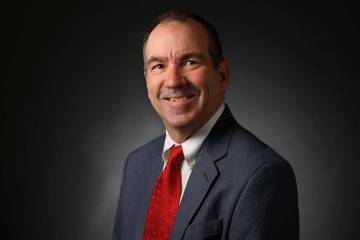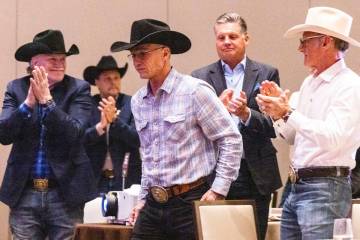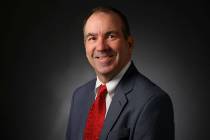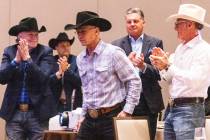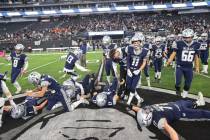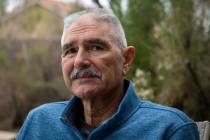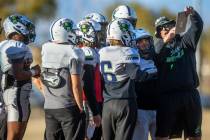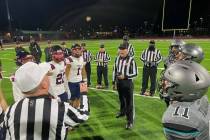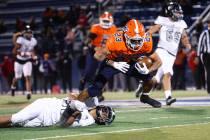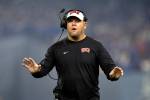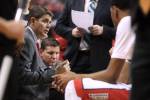Mountain West should take a look at Hamrick’s Herd
Because it’s still college football season — and because UNLV has regressed to its losing ways faster than anybody could have possibly imagined — the subject changes often whenever sports fans gather ’round here this time of year.
And so it was that Mike Hamrick’s name came up.
The former UNLV athletic director was not exactly revered when he resigned in 2009; doors and rear-ends were mentioned in the same sentence. But it has turned out pretty well for him, or so it would seem.
Hamrick is now the athletic director at Marshall, where he once played linebacker. Marshall is 9-0 and appears headed for a big bowl game bonanza if it doesn’t stub its toe.
It was brought up in our little discussion group that while Marshall and UNLV both are midmajor programs tilting at windmills — and though the Power 5 giants are much more mobile than Don Quixote’s — Marshall usually is pretty good in football, while UNLV usually is pretty awful.
This was the case again Saturday against undersized Air Force at Sam Boyd Stadium, where the Rebels came in second, 48-21, and where the weather was perfect, and only 13,481 officially showed up.
So why is it that Marshall almost always wins, and UNLV almost always comes in second?
My quick answer: Marshall has one of the coolest nicknames in sports. The Thundering Herd also has better players, three or four of which annually are NCAA nonqualifiers, which is legal in Conference USA.
The Mountain West has a rule against admitting nonqualifiers. This would explain why New Mexico now is running the triple option, too.
To be considered eligible, recruits must graduate from high school, compete 14 core courses in subjects such as English, math or science, earn a minimum required grade-point average in the core courses and earn a minimum entrance-exam score that is deduced on some sort of sliding scale that only Pythagoras could understand.
If an athlete-student does not meet these requirements, he is classified an NCAA nonqualifier. In theory, he cannot practice or play football at Alabama or Florida for a minimum of one year.
Southeastern Conference schools by rule are allowed to admit two nonqualifiers per football season. But most don’t, because SEC teams can attract good players who aren’t academic risks, because they have nice facilities and winning traditions and such.
So a lot of guys who are nonqualifiers or have checkered pasts wind up at Marshall. It’s become sort of a tradition, dating to Randy Moss.
UNLV, on the other hand, has hired football coaches who have tried to build a program in the manner of those beer dispensers on the concourse, from the bottom up. By and large, they have recruited players who go to class and are solid citizens.
But rarely has that translated to success. Because whereas those who take care of business off the field in the Small Fry conferences usually are 1½-star recruits, the ones who do it in the Big Boy leagues have four and five stars.
So in an attempt to level the playing field, Marshall and North Texas and a few others accept risky academic types who are good football players and hope they take care of business off the field. Many do; many go on to obtain degrees. Some even become doctors and lawyers. On the flip side, sometimes a guy flunks out or a stereo gets stolen.
But if there’s one thing to be learned from observing college football over a period of years, it’s that fans are willing to look the other way when a stereo gets stolen, so long as the team goes 10-2 and beats Disco Tech during ESPN Rivalry Week. And so long as it’s not their stereo that gets stolen.
It usually matters little to fans when a star running back copies off the paper of the smart guy on the O-line once the season is over.
So what do you do to compete when Ohio State has a $109.4 million athletic budget, and you have only midmajor peanuts?
If you’re Marshall, you admit nonqualifiers, then hope they don’t cheat on their midterms or steal a stereo. You also play a weak schedule against teams within driving distance.
In the business that is college football, who can blame them?
With the gap between the Big Boy and Small Fry conferences widening with realignment and playoff and TV money distributions, the Mountain West presidents might want to consider lifting the ban on nonqualifiers, especially now that joining the power conferences is not an option.
It can be a risky strategy, a slippery slope, three years of Double Secret Probation and a bowl ban waiting to happen. But it seems to be working at Marshall. It has turned Mike Hamrick into something of a success story.
Las Vegas Review-Journal sports columnist Ron Kantowski can be reached at rkantowski@reviewjournal.com or 702-383-0352. Follow him on Twitter: @ronkantowski.




